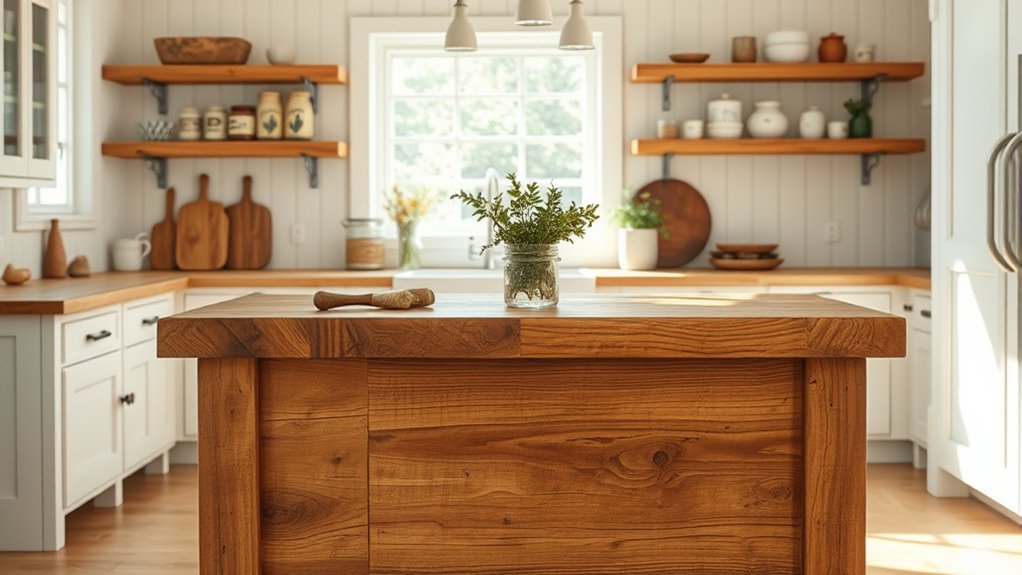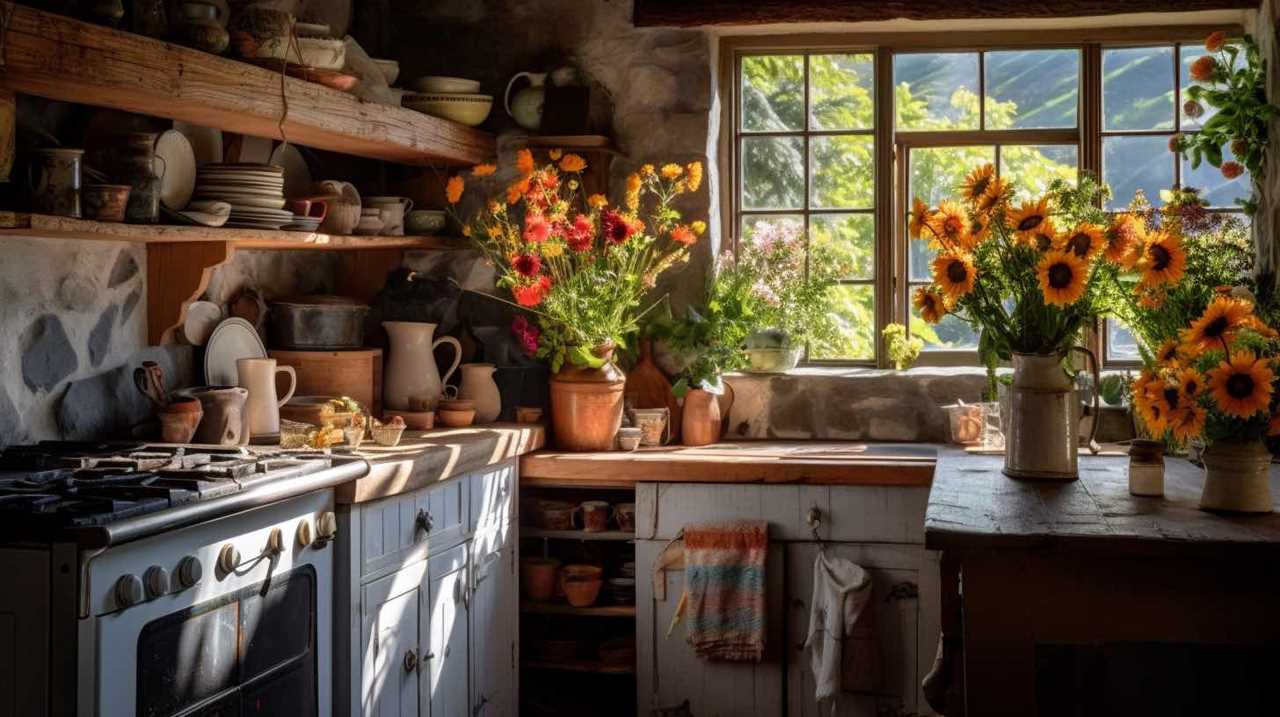A butcher block island adds warmth, rustic charm, and functionality to your farmhouse kitchen, providing a sturdy surface for prep and chopping. It acts as a central gathering spot, enhancing your layout’s flow while blending seamlessly with vintage or modern styles. To keep it looking beautiful and lasting for years, regular maintenance like oiling and gentle cleaning is key. Keep exploring to discover essential tips for caring for your charming centerpiece.
Key Takeaways
- A butcher block island adds warmth, character, and a versatile workspace that enhances the farmhouse kitchen’s charm and functionality.
- Choosing sustainable, responsibly harvested hardwoods ensures durability and aligns with eco-friendly farmhouse design principles.
- Proper maintenance—regular oiling, gentle cleaning, and avoiding harsh chemicals—extends the island’s lifespan and preserves its beauty.
- The island’s style and placement should complement existing kitchen elements for a cohesive, stylish farmhouse look.
- Consistent care prevents damage, resists stains, and keeps the butcher block looking beautiful and sturdy for years to come.

A farmhouse kitchen isn’t complete without a sturdy and charming butcher block island. This essential piece not only adds warmth and character but also serves as a versatile workspace that brings both function and style to your home. When selecting a butcher block, prioritize sustainable materials to guarantee your kitchen remains eco-friendly. Look for options made from responsibly harvested hardwoods like maple, oak, or cherry, which are durable, renewable, and naturally resistant to bacteria. These materials stand up well to daily use, making your butcher block a long-lasting investment. Incorporating sustainable materials isn’t just good for the environment; it also aligns with the rustic charm of farmhouse design, creating a seamless integration that looks both timeless and responsible.
Design integration is equally important. Your butcher block should complement the overall aesthetic of your kitchen, whether it’s rustic, vintage, or modern farmhouse. To achieve this, choose a finish and edge profile that harmonizes with other elements in your space. A smooth, beveled edge paired with a matte finish often works well, blending practicality with visual appeal. Consider how your island fits within the layout—size, placement, and style should enhance the flow and usability of your kitchen. A well-integrated butcher block island acts as the centerpiece, anchoring your design while offering a functional surface for chopping, prep work, or even casual dining. You want it to feel like a natural extension of your kitchen’s character, not an afterthought.
A butcher block should harmonize with your kitchen’s style, serving as a natural, functional centerpiece.
Proper maintenance is also key to preserving its beauty and function. Regularly oil the surface with food-safe mineral oil or beeswax to prevent it from drying out and cracking. This not only keeps the wood looking vibrant but also helps resist stains and moisture absorption. When you use the island, always use a cutting board for raw meats and strong acids like lemon or vinegar to avoid discoloration or damage. Clean the surface with a damp cloth and mild soap after each use, avoiding harsh chemicals that could strip the wood’s finish. Periodically, sand out any scratches or stains with fine-grit sandpaper to keep the surface smooth and inviting. Proper maintenance ensures your butcher block remains a sturdy, beautiful feature that ages gracefully over the years, fitting seamlessly into your farmhouse aesthetic.
Choosing the right wood type and applying proper care techniques can significantly extend the lifespan of your butcher block, making it a cherished part of your home for years to come.
Frequently Asked Questions
Can Butcher Block Islands Be Used Outdoors?
You can use butcher block islands outdoors, but you need to consider outdoor durability and weather considerations. These surfaces are more vulnerable to moisture, sun, and temperature changes, which can cause warping or cracking. To protect your outdoor butcher block, seal it regularly with waterproof finishes, cover it when not in use, and bring it indoors during harsh weather. Proper maintenance helps ensure your island stays functional and attractive outside.
How Do I Remove Deep Knife Cuts From the Surface?
Did you know that a well-maintained butcher block surface can last for decades? To remove deep knife marks, start by sanding the surface gently with fine-grit sandpaper, focusing on the affected area. Wipe away dust and then apply a food-safe oil or butcher block conditioner to restore its appearance. For stubborn marks, you might need to repeat sanding and re-oiling, ensuring your surface stays smooth and beautiful.
Is It Safe to Cut Meat Directly on the Block?
You should avoid cutting meat directly on your butcher block for food safety reasons, as it can harbor bacteria if not properly cleaned. Use proper cutting techniques by placing a separate cutting board for raw meat, then sanitize your butcher block thoroughly afterward. This helps prevent cross-contamination and keeps your surface secure. Always wash your hands and tools regularly to maintain a hygienic workspace and ensure safe food handling.
How Often Should I Re-Oil My Butcher Block?
They say, “A stitch in time saves nine,” and that’s true for your butcher block. To keep it in top shape, follow proper maintenance tips, including regular re-oiling. Generally, you should re-oil your butcher block once a month or when it starts to look dry. Consistent re-oiling helps protect the wood, maintain its beauty, and extend its lifespan. Don’t wait until it’s too late—stay on top of re-oiling frequency.
What Are the Signs That My Butcher Block Needs Replacing?
You’ll know your butcher block needs replacing when the wood grain becomes excessively worn or splintered, making it unsafe for food prep. Surface stains that won’t come out and deep cracks or gouges are signs it’s beyond repair. If the surface feels rough or uneven despite re-oiling, it indicates deterioration. Trust your senses—if it looks or feels compromised, it’s time for a new butcher block to guarantee safety and functionality.
Conclusion
A farmhouse kitchen isn’t complete without a butcher block island, transforming your space into a culinary royal court. Imagine chopping, slicing, and preparing meals on a surface so stunning, it practically whispers “gourmet” with every touch. With proper care, your butcher block will age like fine wine—gaining character and charm—becoming the heart of your home’s flavor and history. So, embrace it, maintain it, and watch your kitchen become an unforgettable masterpiece that lasts for generations.










